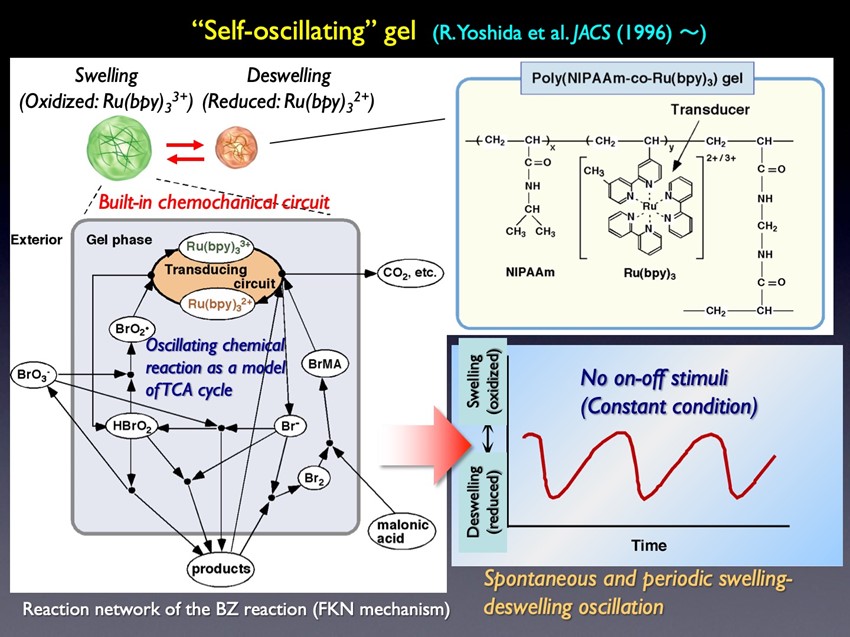YOSHIDA-AKIMOTO Lab.

Department of Materials Engineering
School of Engineering,
The University of Tokyo
Japanese/English
The world’s first gel which autonomously exhibits cyclic swelling and deswelling motion under constant condition in a closed solution like heartbeat.

In the field of polymer science, polymer gels have made rapid progress for the last several decades, and many kinds of stimuli-responsive polymer gels that exhibit reversible swelling-deswelling change in response to environmental changes (e.g, solvent composition, temperature, pH change, light, electric field, etc.) have been developed. Especially, from the late 1980’s, new functional gels called “intelligent” or “smart” gels have been created, and their applications to bio- or biomimetic materials such as actuator (artificial muscle), drug delivery systems (DDS), tissue engineering, purification or separation systems, biosensor, shape memory materials, molecular recognition systems, etc. has been exploited. Furthermore, with the progress of polymer synthesis technology and supramolecular science, gels with unique network structures have been designed to provide rapid response, toughness, and self-healing properties, etc. In these ways, many kinds of stimuli-responsive polymers and gels and their applications inspired by living systems have been studied.
Other than stimuli-responsive function, one of characteristic and important behaviors in living systems is autonomous oscillation, that is, spontaneous changes with temporal periodicity (called “temporal structure”) such as heartbeat, brain waves, pulsatile secretion of hormone, cell cycle, and biorhythm. However, there are few studies on polymer and gel systems undergoing self-oscillation under constant condition without any on-off switching of external stimuli. If such autonomous systems can be realized by using completely synthetic polymers, unprecedented biomimetic materials may be created.

From this viewpoint, “self-oscillating” polymer gels that undergo spontaneous cyclic swelling–deswelling changes without any on–off switching of external stimuli, as with heart muscle, were developed by Prof. Ryo Yoshida in 1996 (J. Am. Chem. Soc., 118, 5134 (1996)). The self-oscillating gels were designed by utilizing an oscillating reaction called the Belousov-Zhabotinsky reaction, as a chemical model of the TCA cycle in living systems.
As a basic chemical structure, the gel is composed of poly(N-isopropylacrylamide) and ruthenium tris(bipyridine) which is covalently bonded to the network as the polymerized catalyst of the BZ reaction. When the gel is immersed in the catalyst-free BZ solution containing the other reactants, the BZ reaction occurs in the gel. The redox changes of the polymerized catalyst moiety change the volume phase transition temperature of the gel as well as the swelling ratio because the hydrophilicity of the polymer chains increases at the oxidized state and decreases at the reduced state. As a result, the gel exhibits an autonomous swelling-deswelling oscillation with the redox oscillation in the closed solution under constant condition.

Since the first report in 1996, Yoshida’s group have systematically studied these self-oscillating polymer gels, and continues to advance the material systems toward novel smart and biomimetic or bioinspired softmaterials. Potential applications of the self-oscillating polymers and gels include several kinds of functional material systems such as biomimetic actuators (Adv. Mater., 19, 3480 (2007), etc.), mass transport systems (Angew. Chem. Int. Ed., 51, 6112 (2012)) and functional fluids. For example, it was demonstrated that an object was autonomously transported in the tubular self-oscillating gel by the peristaltic pumping motion similar to an intestine (Chem. Mater., 26, 5441 (2014)). Further, self-oscillating polymer brush surface like cilia (Angew. Chem. Int. Ed., 52, 7468 (2013)), vesicles or colloidosomes undergoing cell-like autonomous shape oscillations with buckling (Adv. Mater., 27, 837, (2015); Angew. Chem. Int. Ed., 55, 5179 (2016), etc.), was prepared. Besides, autonomous sol-gel oscillation and amoeba-like motion was realized utilizing well-designed block copolymer solution (Nature Commun., 8, 15862 (2017)). Yoshida’s group continue to advance the self-oscillating polymer gel systems.
These Yoshida’s pioneering studies have triggered an innovation in gel science and nonlinear dynamics, and greatly attracted many scientists all over the world in the research fields of polymer chemistry and physics, biophysics, nonlinear equilibrium and dynamics, etc. Other than Yoshida’s group, many researches related to self-oscillating or autonomous polymer gel systems inspired by his study have been now conducted in Europe and America, China, etc.